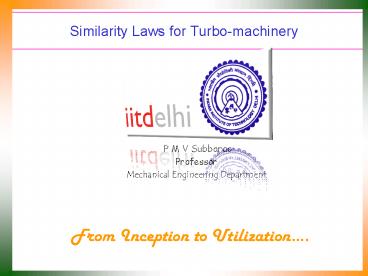Similarity Laws for Turbo-machinery - PowerPoint PPT Presentation
1 / 28
Title:
Similarity Laws for Turbo-machinery
Description:
Similarity Laws for Turbo-machinery P M V Subbarao Professor Mechanical Engineering Department From Inception to Utilization . Buckingham, E. The principle of ... – PowerPoint PPT presentation
Number of Views:275
Avg rating:3.0/5.0
Title: Similarity Laws for Turbo-machinery
1
Similarity Laws for Turbo-machinery
- P M V Subbarao
- Professor
- Mechanical Engineering Department
From Inception to Utilization.
2
Buckingham, E. The principle of similitude.
Nature 96, 396-397 (1915).
3
The purpose of Dimensional Analysis
- Want to determine which variables to study.
- Want to determine the parameters that
significantly affect the system. - Reduce the cost/effort of experimental analysis
by studying the most important groups of
variables. - The ideas can be used for any physical system.
- This will help in the design of scale test models
4
Similitude Dimensional Analysis
- Scale model to prototype design and analysis.
- Used to select proper turbo-machine (axial,
radial or mixed flow,) - Used to define performance parameters
5
Similarity Laws
- GEOMETRIC
- Linear dimension ratios are the same everywhere.
- Photographic enlargement
- KINEMATIC (?m ?p)
- Same flow coefficients
- Same fluid velocity ratios (triangles) are the
same - DYNAMIC (?m ?p)
- Same loading coefficient
- Same force ratios (and force triangles)
- Energetic (Pm Pp)
- Same power coefficient
- Same energy ratios.
6
Eulers GENERIC TURBOMACHINE (turbine,
compressor, pump, .)
- List the n physical quantities (Qn) with
dimensions and the k fundamental dimensions. - There will be (n-k) p-terms.
- Select k of these quantities, none dimensionless
and no two having the same dimensions. - All fundamental dimensions must be included
collectively in the quantities selected.
7
Fundamental Quantities for Turbo-machines
8
The First Non-dimensional Parameter
Flow Coefficient or Capacity Coefficient (f)
the dimensionless swallowing capacity of the
machine
9
Flow Velocity Vs Blade Speed
Volumetric flow rate (Q) can be related to the
fluid velocity
A particular value of f implies a specific
relationship between fluid velocity and
blade/impeller speed.
10
Efficiency (?) vs Flow coefficient (?)
11
Design Innovations for Better Performance
12
Strategies to Capture More Power from Wind
13
Pitch-Controlled Variable-Speed Wind Turbine
Generation
14
Grid Acceptable Power
15
The second Non-dimensional Parameter
- Dp corresponds to the energy per unit volume of
the fluid. - rN2D2 relates to the rotor or impeller dynamic
pressure (K.E. per unit volume). - Loading Coefficient
16
Load Coefficient or Head Coefficient
For compressible fluid machines
For incompressible fluid machines
17
Selection of Load Coefficient for an Axial Flow
Compressor
18
Accepted Technology for Hydro Power generation
19
Universal Design Chart for Power Consuming
Turbo-machines
20
The Third non-dimensional Parameter
21
Role of Power Coefficient Wind Turbines
22
Size Vs Capacity of A Wind TUrbine
23
(No Transcript)
24
Design Upgradation
25
(No Transcript)
26
Similarity of Model Prototype
27
Design for Best Efficiency for Pumps Fans
28
Dimensions for Performance































